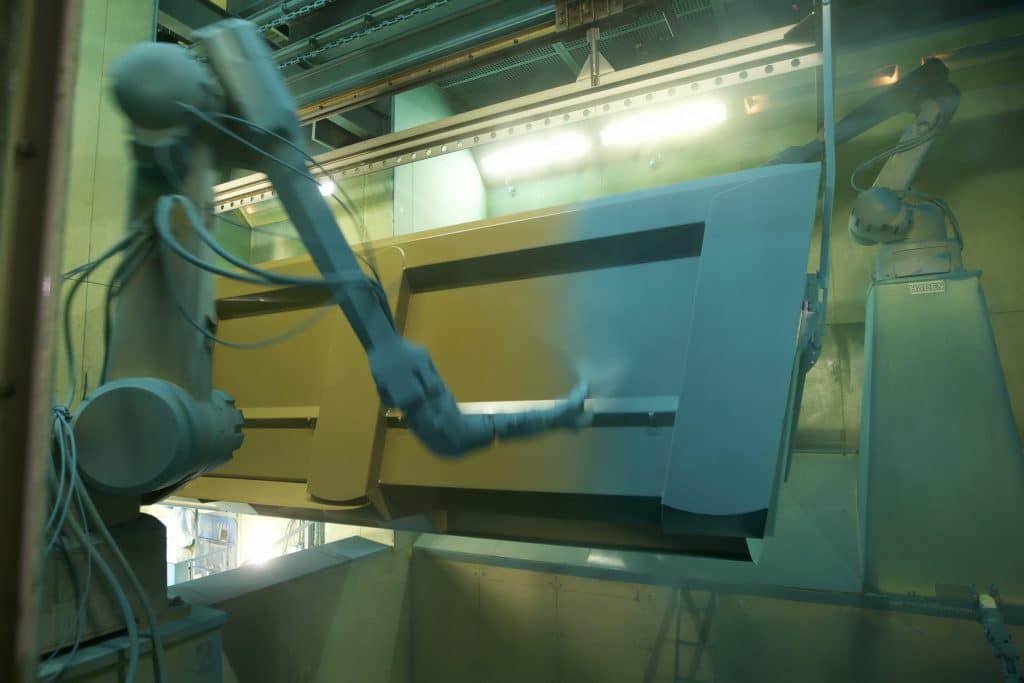
EnvironmentThe painting process
Rolland painting process
1) Mechanical shot-blasting
The first step of our process consists to mechanically clean all the parts by shot-blasting. All the welded parts go into the shot-blasting machine that is a 40m cabin equipped with 24 turbines blasting angular shot at 300km/hr. The turbines blast the shot all around the parts and bodies.
Target : Remove all oxidation signs and obtain the necessary surface roughness to ensure an optimal cataphoresis accroche.


2) Surface treatment
The second step consists in a surface treatment high pressure jets and 4 dipping bathes. This step called “surface treatment” and is realized in 5 different baths.
- The 1st bath is equipped with ramps and aspersion nozzles following the principle of high pressure cleaning. This a hot degreasing step (50°C) that removes all the dust and metal residues.
- The 2nd bath allows a complete immersion in a hot phosphating bath. This step completely finishes the degreasing, even inside the tubes. The phosphating is a chemical protection call conversion, which significantly improves the painting protection against corrosion.
- Three rinsing dips and a demineralised water aspersion finalize the preparation. This last step consists in removing all chemical products and avoiding salt deposits and to have a perfectly clean surface for the cataphoresis coating.
3) Cataphoresis (Pirmary anti-corrosion process)
This painting technic consists in dipping the part into a bath of water-soluble paint, by placing the part as a cathode (giving rise to the name Cataphoresis) and by making merging the painting particles in suspension in the bath from the anode to the cathode by putting an electric current.
- The paint particles uniformly stick on all the surface of the dipped part. Even inside tube or cavities.
- Then, the parts are dipped in two other rinsing baths for ultra-filtration, where the excess of paint is removed. Those baths are links to the cataphoresis bath using the principle of inverted cascade. Thus, every excedent of paint comes back to the principal bath.
- Such as all the installation, this technical process is totally automatic and many parameters are daily checked by our expert team (pH, electrical conductance, dry extractions, temperature, % of particles etc).
- To finalize this third step, all the parts are oven cured a 210°C; this chemical step is called polymerization. The oven time depends on the type of part (surface, thickness etc).
Benefits of the cataphoresis:
- All the surface of the part is coated, including the hidden spaces and sharp edges (in contrary to electrostatic paint gun process)
- The regular coat, approximatively 30 microns. The control of the thickness is made at the exact micron and made through rigorous controls of dipping time, bath temperature, tension and intensity on the crane.
- The homogeneous cataphoresis coat confers an excellent resistance to corrosion and a good accroche for the final powder coating.
- The coating performance of the cataphoresis process approaches 99% . The low-solvent use make the process eco-friendly.


4) The top coating
- The last step consists in top coating. The parts go into the robotized powder coating cabin. Five multi-axis painting robots apply the powder following pre-registered specific trajectories.
- This process is non-polluting and solvent-free. The circuit works recycling the powder to avoid wastes. The powder is a polyester basis cookable resin.
- The robotized process is completed by a manuel pre-paint and post-paint with control. The polyester paint present high UV and weather resistance as well as mechanical resistance.
- Such as for cataphoresis, this step is finalized by an oven cure which duration also depends on the type of part (surface, thickness etc).
- After cooling and many quality controls, the parts are ready for assembling.

5) Safety
- All the manutentions are made automatically wuth pushovers in order to ensure traceability and quality.
- The operators don’t handle the parts and don’t have contacts with solvents.
